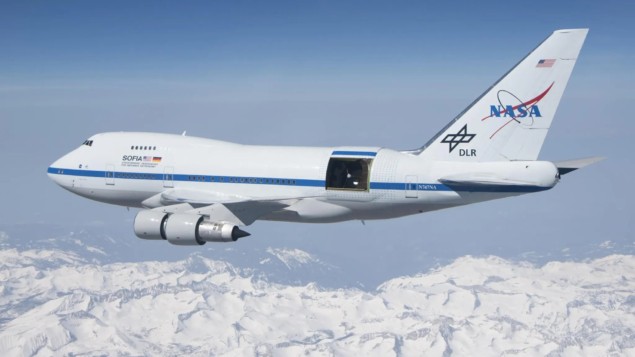
The first direct observation of water on the surface of an asteroid has been made using an airborne near-infrared telescope. Water was detected on two stony S-type asteroids, which are thought to have been born dry. The discovery could provide insights into the complex and eventful history of the solar system’s minor bodies – and in particular, how their orbits may have evolved over time.
“There are a few theories out there that describe an event that would have shuffled up the asteroid belt,” explains Anicia Arredondo of the Southwest Research Institute in San Antonio, Texas. Arredondo led the team that found the water and she tells Physics World, “During that time, water could have been transferred to [S-type asteroids]”.
Hydrated minerals including carbonates, hydroxides, phyllosilicate and sulfates have previously been detected on the surface of hundreds of asteroids. These detections were all made by studying near-infrared light with wavelengths around 3 micron. Such light is associated with the oxygen–hydrogen bond found in water molecules as well as the simpler hydroxyl(OH) group. As a result, it had not been possible to distinguish between water and hydroxyl on the asteroids.
Jumbo jet
To tell the difference between water and hydroxyl, Arredondo’s team turned to a joint NASA–German Aerospace Agency mission called the Stratospheric Observatory for Infrared Astronomy (SOFIA). Carried by a Boeing 747SP that flew up to 13 km, SOFIA was a 2.7 m diameter infrared telescope that peers through a hatch in the side of the plane.
In 2021, astronomers led by Casey Honniball of NASA’s Goddard Space Flight Center used SOFIA to confirm the existence of water molecules on the sunlit face of the Moon. It did so by detecting a mid-infrared signal at 6.1 micron, produced only by the chemical bond of water molecules.
SOFIA flew its final flight in 2022, but not before Arredondo’s group had teamed up with Honniball to do similar observations of four S-type asteroids that had previously be found to have the ambiguous 3 micron signature.
SOFIA’s FORCAST instrument was able to confirm the presence of water molecules on the surface of two asteroids: 7 Iris and 20 Massalia. The two other asteroids, 11 Parthenope and 18 Melpomene, proved to be too faint for SOFIA to determine whether they have water or not.
Small amounts
In its observations of the Moon, SOFIA found that each cubic metre of regolith (surface material) contained about a third of a litre of water. The signals from Iris and Massalia suggest similarly small amounts of water on the surface of those asteroids.
What form this water takes is currently unknown. One possibility is that it has been adsorbed onto silicates in the regolith, forming a thin film. Or the water could be chemically bound in minerals in the regolith.
Both of these scenarios would imply that Iris and Massalia were created with this water in place. However, astronomers think that S-type asteroids formed close to the Sun, where high temperatures would have driven away water.
A third possibility is that the water was brought to the initially dry asteroids by collisions with objects containing water. In this scenario, water would be trapped inside microscopic glass beads that were formed during the collisions.
Wandering planets
The impacts could have occurred at times when some asteroids and planets are believed to have shifted their orbits. Several models – including Nice, Grand Tack and Jumping Jupiter – all posit that early in the history of the solar system the orbits of several of the planets changed.
“These models all describe the movement of the giant planets, which would have caused gravitational perturbations on asteroids and shuffled them up,” explains Arredondo. “Jupiter would have had the greatest effect because it is biggest.”
The Grand Tack model suggests that Jupiter moved towards the Sun, which would have pushed the S-type asteroids away from the Sun. The model then says that Jupiter migrated away from the Sun, where it encountered the carbonaceous C-type asteroids. These formed farther out from the Sun than the S-type and are therefore expected to contain water.
Jupiter would have scattered the C-types inwards, coming together with the S-types to form the asteroid belt. Today the S-types populate the inner regions of the asteroid belt and the C-types the outer part. As they mixed, there would have been collisions, with small C-types raining down on the larger S-types. This provides an explanation for how water reached S-type asteroids.
Search continues with JWST
While scientists believe C-type asteroids should contain water, this has yet to be confirmed. This cannot be resolved by SOFIA, which has been retired. So, Arredondo’s team has turned to the James Webb Space Telescope (JWST) to look for the same 6.1 micron signature on C-type asteroids.

Luminous protostar sheds light on the origins of Earth’s water
“So far we have observed two main-belt asteroids [with the JWST], and have submitted a proposal to observe even more,” Arredondo tells Physics World. These C-type asteroids are 142 Polana and 225 Henrietta.
“We’ve not yet completed the analysis to see whether or not they have water,” says Arredondo, “But based on instrument specifications, the JWST should be sensitive enough to detect the feature we are looking for”.
The team also hopes that discovering where water is located in the asteroid belt will help shed light on the origin of Earth’s water. This is believed to have arrived via impacts, but whether the collisions were with comets, C-type asteroids or even S-types is uncertain.
The research is described in The Planetary Science Journal.
- SEO Powered Content & PR Distribution. Get Amplified Today.
- PlatoData.Network Vertical Generative Ai. Empower Yourself. Access Here.
- PlatoAiStream. Web3 Intelligence. Knowledge Amplified. Access Here.
- PlatoESG. Carbon, CleanTech, Energy, Environment, Solar, Waste Management. Access Here.
- PlatoHealth. Biotech and Clinical Trials Intelligence. Access Here.
- Source: https://physicsworld.com/a/water-observed-on-asteroids-for-the-first-time/



